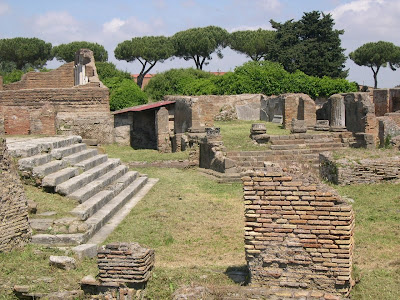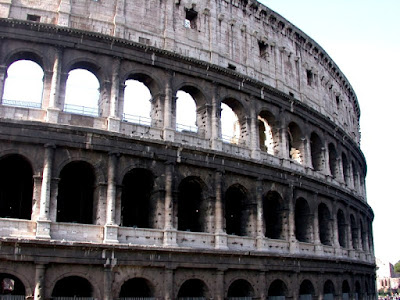Intellectually curious? One of our very favorite organizations in the world of travel is Context Travel. We've interviewed them before, and I am always impressed by the scholarly tone that they bring to travel. I recently asked Paul Bennett, founder of Context Travel, to if we could interview some of his docents. Luckily for us, we have been able to do just that.
Here's the fourth of several excellent interviews with a docent of Context Travel, Alvaro Higueras, who is based in Rome.

Alvaro is an Italo-peruvian archaeologist with a Ph.D. from the University of Pittsburgh (1996). He learned archaeology in Peru and had a 15-year period of excavations in Peru and Bolivia before moving to the Old World. He has been an archaeology professor in India and Eritrea, and then a cultural manager in Kosovo and Bosnia. In Bosnia he has also conducted forensic excavations, as well as studies in provincial Roman villages and cemeteries. He resides in Rome where he continues working as a consultant in cultural management, focusing mainly in the "museum" potential of open spaces (parks and areas with architectural remains of Roman times).
WE: Please tell us about your walking tour with Context Travel...
AH: I lead several walks at Context, all of them related to the monuments of Classical Rome and to the early centuries of Christianity. These two "themes" overlap as Christian religion grows and coexists within Roman society (in which it is periodically persecuted but where it finds most of its followers). Staring with Constantine and the Theodossius, Christianity will predominate over all the other religions at the turn of the V century AD ending a long period of religious liberties in the Empire -except for Christians.
While I enjoy very much the walks through the central archaeological area of Rome with the Imperial palaces, the Roman Forum and the Colosseum, it is in the visits to the Christian churches and their underground buildings where I can provide a clear explanation (and experience) of the evolution of Roman society through the centuries of the empire and into Christian times. In other words, these are visits that reveal the vertical scale which shows that the current city of Rome is built squarely over the ancient city, and that only portions of the latter have been -and will ever be- unearthed. This is the case for current churches built over previous ones and over remains of the city of Classical times, as is the case in San Clemente or San Lorenzo in Lucina.
Overall, the walks we offer at Context depend as much about the monumental evidence we see around us as of the historical context and times in which those monuments were built. Essential to this exercise is to always place the monuments in their historical context: never forget that it is political decisions that define the presence of a monument and not the other way around. Monuments alone have less interest. They are indeed more "academic" walks rather than touristic ones. So I make sure that our visitors obtain a broad and satisfying picture of Roman society as seen through its temples and churches.
WE: What is your background; what led you to be interested in this city and subject matter?
AH: My academic background is archaeology and only later I have developed my interests into the field of cultural heritage management. You can understand that both discplines find an incredibly fruitful niche in Rome. My perception of Roman archaeology grows from my personal readings and interest in the monuments of the city. In other words, I approached Roman archaeology with only some vague knowledge of its monuments and their history, much like any other visitor with much interest in the city. Granted, I am strongly helped by my familiarity with archaeology. For example, in a stroll in mid-july in the Forum you meet teams of students excavating below the apparent Roman level or removing the fill of large rooms next to the Arch of Constantine. My background allows me to understand what is going on in those pits that many visitors just observe. It is exactly here where starts the flow of information that I am interested in providing the visitors: "I understand it" (differently than "I know what it is..."), then let me explain it to you and share my excitement for these monuments."
WE: What things do you love to share, on your walking tours?
AH: Along with the pleasure of leading walks around the city I work as a cultural manager, that is assessing and projecting the management of archaeological evidence in urban areas as, for example, parks. Therefore I have a very critical view of the many problems Rome, as a city listed in the World Heritage List, confronts on a day-by-day basis.
During my walks I pinpoint how the evolution of the city in the last three centuries (and especially the 20th century) has created the image we now can appreciate (the retaining walls in the Colosseum, the wide and bury Via dei Fori Imperiali...). Because I start mentioning this interest, many visitors will address problems they perceive in the monuments, such as the smog still blackening the travertine blocks of the Colosseum. It is difficult for them to understand why they have not been properly cleaned already. Therefore, part of the arguments discussed is the problems affecting the monuments and flaws in the management that affect the "experience" visitors have in the historical sites in the city.
While I believe that Rome is the most exciting city in the world, the reason why I decided to settle here, I do have days where I am awfully critical of the status quo in the city's organization, mainly because I believe it could be so much welcoming and attractive. I am usually critical until a next round of visits where the richness and spectacularity of the monuments gives me back the joy to be a Roman neighbor. While I would not qualify it as a love-hate relationship with the city, I am constantly thinking of better ways to make things work for the benefit of we Romans and tourists.
WE: What is unique about your Context Tour?
AH: What makes my tours unique is something that makes all tours with Context docents unique. We are clearly commited to enjoy ourselves in the experience of showing the city to the visitors, presenting ideas and facts we have read, studied and analyzed in the libraries and excavations in the city, to make it a strong yet interesting visit to the monuments. Personally, I wish my visitors to understand the profound interest and pleasure I have at walking the city with them and how much I myself enjoy admiring the monuments again and again. Then, with all my references to the modern care and management of Rome, I try to make it a living archaeological site, a modern city that has to deal with its past in a intelligent and concious manner.

One of the most exciting museums in the city, the National Museum of the Crypta Balbi, started limited to the corner of the city block (the white building in the background), presenting one edge of a large portico spanning the block and that flanked the Teatro Balbo (today, under the ochre building on the left). The decision to excavate most the block, removing a monastery and habitation buildings is producing the most interesting data on the urban evolution of the city. The museum is eventually set to expand its visiting area and will provide an outstanting experience of urban archaeology.
During the summer months the Forum comes alive with excavations in
many of its corners...In some cases they are still removing the fill of
the entrance hall to the Domus Aurea, in others exploting pre-Roman
levels, and here, discovering the memorial monuments that lined up the
facade of the basilica Emilia that faced the via Sacra. A great
experience because the central part of the Forum is devoid of all the
statues that used to lay in state ...a real forest of marble, say...
The frontal part of the basilica shows how dense the memorials, podiums
and statues were in Classical times.

The most underrated site in Rome, Ostia Antica, the ancient port of the city, is an extraordinarily easy trip from the center to witness an outstanding Roman town. Covered by the silt from centuries of floods of the Tiber river it has been excataved in the last 150 year to uncover extraordinary examples of mural paintings of the rich traders living in the first floors of buildings that popualted the city. Context Travel, with its green appproach to tourism, wants to promote it as a solid alternative to Pompei (granted, without the volcano).

The Colosseum with its contrasting colors, witness of the heavy problems Roman monuments has in the 50's and 60's with acid rain and smog.
WE: Thanks so much, Alvaro! I think that your approach to sharing Rome is extraordinary. I can tell the love of place and history that you have, just from this short interview. I can't wait to get to Rome and explore with you!
For more information on Context Travel, please see: http://www.ContextTravel.com
